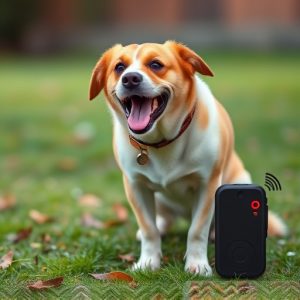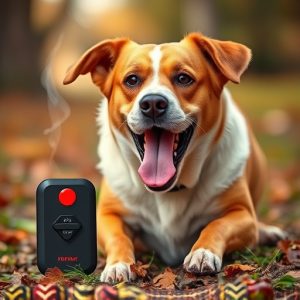Electronic Pet Behavior Correction Tools: Safety, Effectiveness, and Training
Electronic dog repellent devices, utilizing safe technologies like static electricity or ultrasonic…….
Electronic dog repellent devices, utilizing safe technologies like static electricity or ultrasonic sounds, are effective tools for pet training. These devices require compliance testing to meet industry standards for safety and performance, ensuring they don't harm pets. Proper preparation, structured training with positive reinforcement, and regular monitoring with adjustments based on your pet's needs are crucial for successful integration and effectiveness without causing distress.
“Discover the revolutionary power of Electronic Pet Behavior Correction Tools, designed to gently guide your furry friends. This comprehensive guide explores the inner workings of these innovative devices, shedding light on how they effectively address problematic behaviors in dogs. From understanding their mechanism to ensuring safety through crucial compliance testing, we demystify these tools. Learn about preparation techniques and device adjustments for optimal results. Uncover why choosing the right repellent device is essential for your pet’s well-being and behavior correction.”
- Understanding Electronic Pet Behavior Correction Tools
- How Dog Repellent Devices Work
- The Importance of Compliance Testing for Safety and Effectiveness
- Preparing Your Pet for a Repellent Device
- Monitoring and Adjusting the Device for Optimal Results
Understanding Electronic Pet Behavior Correction Tools
Electronic pet behavior correction tools, also known as dog repellent devices, are innovative solutions designed to train and modify an animal’s behavior through safe and humane methods. These devices use various technologies like static electricity, ultrasonic sounds, or vibration to deter unwanted actions such as barking, jumping on furniture, or aggression. Understanding how these tools work is crucial for their effective and responsible use.
Compliance testing plays a significant role in ensuring the safety and reliability of electronic pet behavior correction tools. Dog repellent device compliance testing involves rigorous evaluations to meet industry standards and regulations. These tests assess factors like device sensitivity, activation range, and energy output to guarantee that they function as intended while minimizing any potential harm to pets. By adhering to these strict guidelines, manufacturers ensure the well-being of animals and promote responsible pet ownership.
How Dog Repellent Devices Work
Dog repellent devices, also known as electronic static field generators, work by emitting a low-level, harmless electrostatic pulse to deter unwanted canine behavior. These tools are designed to disrupt a dog’s sense of smell and touch temporarily, making them less likely to engage in actions like barking, jumping on furniture, or digging. The device emits an invisible field that interferes with the dog’s ability to detect certain scents, effectively redirecting their focus and behavior.
Compliance testing for Dog Repellent Devices is crucial to ensure their safety and effectiveness. This involves rigorous assessments to meet industry standards, focusing on factors like frequency range, power output, and pulse duration. The testing guarantees that these devices operate within safe limits, are consistent in their performance, and remain non-harmful to dogs’ overall well-being. By undergoing such tests, manufacturers ensure their products adhere to regulations, providing pet owners with peace of mind and effective behavior correction tools.
The Importance of Compliance Testing for Safety and Effectiveness
In the realm of electronic pet behavior correction tools, particularly dog repellent devices, Dog Repellent Device Compliance Testing plays a pivotal role in ensuring both safety and effectiveness. Before any product hits the market, rigorous testing is imperative to verify that it operates as intended without causing harm to animals or humans. This involves assessing the device’s ability to emit safe, effective signals while minimizing potential adverse effects on pet behavior and health.
Compliance testing includes verifying the device’s output power, frequency range, and signal intensity, ensuring they align with regulatory standards for electromagnetic radiation. Moreover, it evaluates the repellent effect under various conditions, guaranteeing its reliability in different environments. Ultimately, this process safeguards users and their pets, fostering a harmonious coexistence between humans and animals.
Preparing Your Pet for a Repellent Device
Preparing your pet for a dog repellent device is a crucial step in ensuring its effectiveness and your pet’s comfort. Before introducing any electronic behavior correction tool, it’s essential to establish a routine that helps them get accustomed to the new sensation. Start by allowing your pet to investigate the device at their own pace; keep it in a visible yet not overly intrusive location where they can approach and sniff without feeling threatened. Positive reinforcement training, such as rewarding calm behavior around the device with treats or praise, can help reduce any potential anxiety.
Once your pet is comfortable with the physical presence of the dog repellent device, it’s time for compliance testing. This involves simulating real-world scenarios to check if the device functions as intended without causing undue stress or harm. During these tests, ensure you follow local regulations and guidelines, particularly regarding safety standards and usage limits. Regular practice sessions will help your pet learn to respond appropriately to the device’s stimulus, reinforcing good behavior and gradually reducing unwanted actions.
Monitoring and Adjusting the Device for Optimal Results
For optimal results with an electronic pet behavior correction tool, proper monitoring and adjustments are key. After selecting a device suitable for your pet’s needs—whether it’s a dog repellent or other behavioral modifier—it’s crucial to understand how it works and where to place it. Begin by reading the manufacturer’s instructions and conducting compliance testing to ensure the device operates within safe and effective parameters. Regularly check the settings, ensuring they are tailored to your pet’s size, breed, and behavior. Adjusting the sensitivity levels and timing mechanisms can help prevent over-correction while still reinforcing desired behaviors.
During monitoring, pay close attention to your pet’s reaction and behavioral changes. Keep a log of their activities, noting when incidents occur and under what conditions. This data will aid in fine-tuning the device settings for maximum effectiveness. Remember, consistency is vital; regular checks and adjustments will help you maintain optimal conditions, ensuring positive results without causing distress or discomfort to your pet.
Electronic pet behavior correction tools, particularly dog repellent devices, can be effective in modifying unwanted behaviors. Understanding how these devices work, the importance of compliance testing for safety and effectiveness, proper preparation and monitoring are key to achieving optimal results. By following these guidelines, pet owners can ensure their pets’ well-being while enjoying a more harmonious living environment. Remember, consistent training and positive reinforcement go hand in hand with using a dog repellent device for long-lasting behavior correction.


